Proteomic analysis of cervical-vaginal fluid: identification of novel biomarkers for detection of intra-amniotic infection
- PMID: 17203952
- PMCID: PMC2532920
- DOI: 10.1021/pr060149v
Proteomic analysis of cervical-vaginal fluid: identification of novel biomarkers for detection of intra-amniotic infection
Abstract
Intra-amniotic infection (IAI) is associated with preterm birth and perinatal mortality. To identify potential biomarkers, we performed a comprehensive survey of the cervical-vaginal fluid (CVF) proteome from a primate IAI model utilizing multidimensional protein identification technology (LC/LC-MS/MS) and MALDI-TOF-MS analyses. Analyses of CVF proteome identified 205 unique proteins and differential expression of 27 proteins in controls and IAI samples. Protein expression signatures and immunodetection of specific biomarkers identified can be employed for noninvasive detection of IAI.
Figures



Similar articles
-
Diagnosis of intra-amniotic infection by proteomic profiling and identification of novel biomarkers.JAMA. 2004 Jul 28;292(4):462-9. doi: 10.1001/jama.292.4.462. JAMA. 2004. PMID: 15280344
-
Comprehensive proteomic analysis of human cervical-vaginal fluid.J Proteome Res. 2007 Apr;6(4):1258-68. doi: 10.1021/pr0605419. Epub 2007 Mar 21. J Proteome Res. 2007. PMID: 17373839
-
Non-invasive prediction of intra-amniotic infection and/or inflammation in patients with cervical insufficiency or an asymptomatic short cervix (≤15 mm).Arch Gynecol Obstet. 2015 Sep;292(3):579-87. doi: 10.1007/s00404-015-3684-3. Epub 2015 Mar 12. Arch Gynecol Obstet. 2015. PMID: 25762201
-
Candidate biomarkers in the cervical vaginal fluid for the (self-)diagnosis of cervical precancer.Arch Gynecol Obstet. 2018 Feb;297(2):295-311. doi: 10.1007/s00404-017-4587-2. Epub 2017 Nov 15. Arch Gynecol Obstet. 2018. PMID: 29143101 Free PMC article. Review.
-
Mass spectrometry-based proteomics for pre-eclampsia and preterm birth.Int J Mol Sci. 2015 May 14;16(5):10952-85. doi: 10.3390/ijms160510952. Int J Mol Sci. 2015. PMID: 26006232 Free PMC article. Review.
Cited by
-
Characterization of the Human Cervical Mucous Proteome.Clin Proteomics. 2010 Jun;6(1-2):18-28. doi: 10.1007/s12014-010-9042-3. Epub 2010 Mar 9. Clin Proteomics. 2010. PMID: 20461121 Free PMC article.
-
Use of nonhuman primate models to investigate mechanisms of infection-associated preterm birth.BJOG. 2011 Jan;118(2):136-44. doi: 10.1111/j.1471-0528.2010.02728.x. Epub 2010 Oct 13. BJOG. 2011. PMID: 21040390 Free PMC article. Review.
-
The role of proteomics in the diagnosis of chorioamnionitis and early-onset neonatal sepsis.Clin Perinatol. 2010 Jun;37(2):355-74. doi: 10.1016/j.clp.2010.03.002. Clin Perinatol. 2010. PMID: 20569812 Free PMC article. Review.
-
Utility of proteomics in obstetric disorders: a review.Int J Womens Health. 2015 Apr 13;7:385-91. doi: 10.2147/IJWH.S79577. eCollection 2015. Int J Womens Health. 2015. PMID: 25926758 Free PMC article. Review.
-
Proteomics/diagnosis of chorioamnionitis and of relationships with the fetal exposome.Semin Fetal Neonatal Med. 2012 Feb;17(1):36-45. doi: 10.1016/j.siny.2011.10.002. Epub 2011 Nov 21. Semin Fetal Neonatal Med. 2012. PMID: 22100864 Free PMC article. Review.
References
-
- Goldenberg RL, Hauth JC, Andrews WW. Intrauterine infection and preterm delivery. N Engl J Med. 2000;342(20):1500–7. - PubMed
-
- Newton ER. Chorioamnionitis and intraamniotic infection. Clin Obstet Gynecol. 1993;36(4):795–808. - PubMed
-
- Martin JA, Hamilton BE, Sutton PD, Ventura SJ, Menacker F, Munson ML. Births: final data for 2003. Natl Vital Stat Rep. 2005;54(2):1–116. - PubMed
-
- Hitti J, Riley DE, Krohn MA, Hillier SL, Agnew KJ, Krieger JN, Eschenbach DA. Broad-spectrum bacterial rDNA polymerase chain reaction assay for detecting amniotic fluid infection among women in premature labor. Clin Infect Dis. 1997;24(6):1228–32. - PubMed
-
- Watts DH, Krohn MA, Hillier SL, Eschenbach DA. The association of occult amniotic fluid infection with gestational age and neonatal outcome among women in preterm labor. Obstet Gynecol. 1992;79(3):351–7. - PubMed
Publication types
MeSH terms
Substances
Grants and funding
LinkOut - more resources
Full Text Sources
Other Literature Sources
Medical

